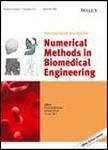版权所有:内蒙古大学图书馆 技术提供:维普资讯• 智图
内蒙古自治区呼和浩特市赛罕区大学西街235号 邮编: 010021

作者机构:Istanbul Tech Univ Fac Aeronaut & Astronaut TR-34469 Istanbul Turkey
出 版 物:《INTERNATIONAL JOURNAL FOR NUMERICAL METHODS IN BIOMEDICAL ENGINEERING》 (工程数值法快报)
年 卷 期:2019年第35卷第2期
页 面:e3171-e3171页
核心收录:
学科分类:0831[工学-生物医学工程(可授工学、理学、医学学位)] 0710[理学-生物学] 07[理学] 070104[理学-应用数学] 0701[理学-数学]
基 金:National Center for High Performance Computing of Turkey (UYBHM)
主 题:buckling instability compatible interface condition fluid-structure interaction monolithic approach red blood cell deformation
摘 要:A parallel fully coupled (monolithic) fluid-structure interaction (FSI) algorithm has been applied to the deformation of red blood cells (RBCs) in capillaries, where cell deformability has significant effects on blood rheology. In the present FSI algorithm, fluid domain is discretized using the side-centered unstructured finite volume method based on the Arbitrary Lagrangian-Eulerian (ALE) formulation;meanwhile, solid domain is discretized with the classical Galerkin finite element formulation for the Saint Venant-Kirchhoff material in a Lagrangian frame. In addition, the compatible kinematic boundary condition is enforced at the fluid-solid interface in order to conserve the mass of cytoplasmic fluid within the red cell at machine precision. In order to solve the resulting large-scale algebraic linear systems in a fully coupled manner, a new matrix factorization is introduced similar to that of the projection method, and the parallel algebraic multigrid solver BoomerAMG is used for the scaled discrete Laplacian provided by the HYPRE library, which we access through the PETSc library. Three important physical parameters for the blood flow are simulated and analyzed: (1) the effect of capillary diameter, (2) the effect of red cell membrane thickness, and (3) the effect of red cell spacing (hematocrit). The numerical calculations initially indicate a shape deformation in which biconcave discoid shape changes to a parachute-like shape. Furthermore, the parachute-like cell shape in small capillaries undergoes a cupcake-shaped buckling instability, which has not been observed in the literature. The instability forms thin riblike features, and the red cell deformation is not axisymmetric but three-dimensional.